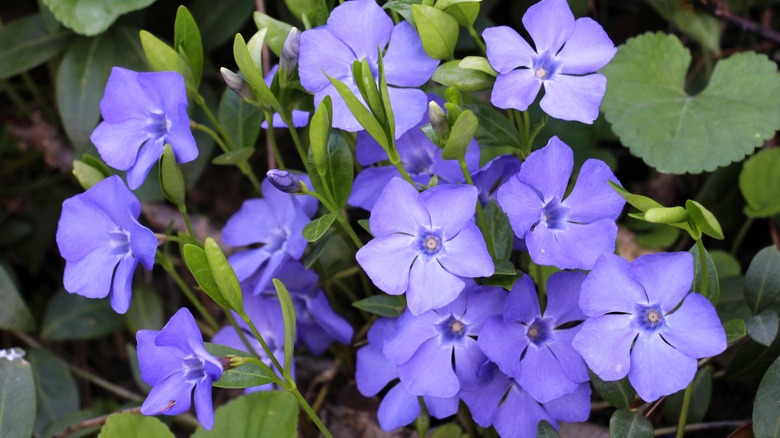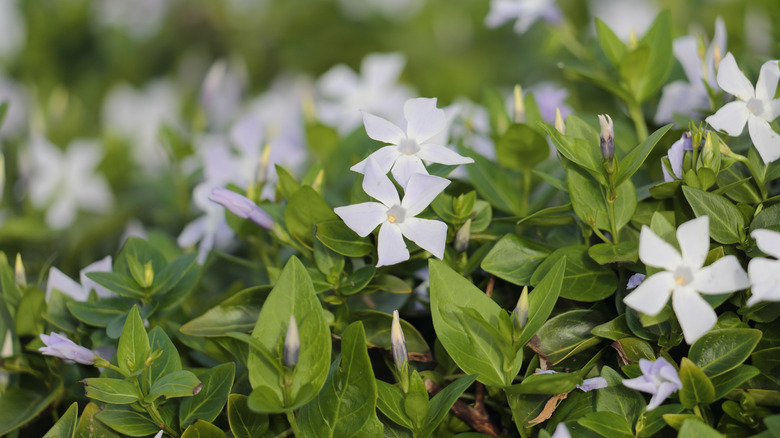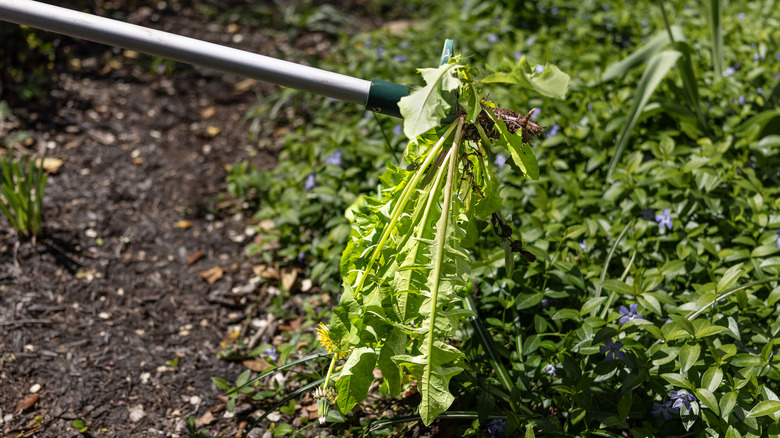The Pros And Cons Of Using Periwinkle As A Ground Cover Or Grass Alternative
Periwinkle (Vinca minor) is one of those plants that seems too good to pass up. It covers ground quickly, looks beautiful year-round, and thrives in spots where grass tends to fail – especially under trees or along shaded slopes. There are two species that go by periwinkle: Vinca minor and Vinca major. Both have similar growth habits, though Vinca minor is slightly smaller than its relative. With its glossy evergreen leaves and colorful starry flowers, vinca offers an easy way to fill bare spaces without the hassle of mowing or reseeding. For gardeners who want a low-maintenance alternative to turf, this flowering ground cover often looks like the perfect solution.
But that same low-maintenance appeal can come at a cost. Periwinkle flowers spread by rooting wherever their stems touch soil, which means they don't always stay where they're planted. Without barriers or regular trimming, the plant can creep past garden beds, overwhelm nearby plants, and invade natural areas. In some states, it's even considered invasive — be sure to search for both Vinca major and Vinca minor in your state for its status. While its durability and dense coverage make it a favorite for solving tricky landscape problems, its aggressive growth habit can just as easily turn it into a problem of its own.
Pros of using periwinkle as ground cover
Vinca minor's biggest appeal lies in how easily it fills tough spots where most plants struggle. It grows well in full shade, partial sun, or anything in between, which makes it ideal for planting under trees or around shrubs. Once established, it spreads into a dense, evergreen mat that suppresses weeds and holds soil in place. In spring, the flowers of this perennial ground cover bloom in soft blue or lavender shades and occasionally white, adding a gentle pop of color that brightens up shady corners. Vinca minor also holds onto its foliage year-round, giving beds a tidy, green look even in colder months.
Compared to Vinca major, Vinca minor is much better suited to colder climates. It handles winter well in USDA Hardiness Zones 4 to 9 and barely needs any attention. You won't have to water it much, and it's not on the menu for deer or rabbits. If your area gets frost, a bit of mulch is usually all it takes to keep the roots safe. Moreover, thanks to its trailing habit, Vinca minor isn't just for garden beds. It grows well in containers, hanging baskets, and rock gardens and can thrive in just about any soil that isn't completely dry.
Cons of using periwinkle as ground cover
However, apart from its benefits, periwinkle comes with some serious red flags too, especially if you're not prepared to keep it in check. The same qualities that make it such a reliable ground cover also make it hard to control. It spreads by rooting along its stems, and once it gets going, it doesn't stop at the garden bed. In many parts of North America, it is considered invasive because it forms thick mats that crowd out native plants and disrupt forest ecosystems.
Another one of the most persistent problems with vinca is that it doesn't offer much to wildlife. Its leaves contain alkaloids that make it poisonous to most animals, and its flowers don't attract many pollinators. That means it can smother native ground covers without replacing the food or shelter they provide. And once it takes over, getting rid of it is no small task. The vines root so easily that even a small leftover piece can start a new patch. Pulling it often leads to regrowth, and removing it completely usually takes repeated effort, or herbicides, to get every last root.
There are also practical drawbacks in the garden. Vinca minor doesn't hold up to foot traffic the way turf does, so it's not suited for play areas or pathways. It's better used as a visual filler than as a true lawn replacement. On top of that, since all parts of the plant are toxic if ingested, it's a poor choice around pets or children. Be prepared to keep it in bounds or this easygoing ground cover might end up running the whole show.


